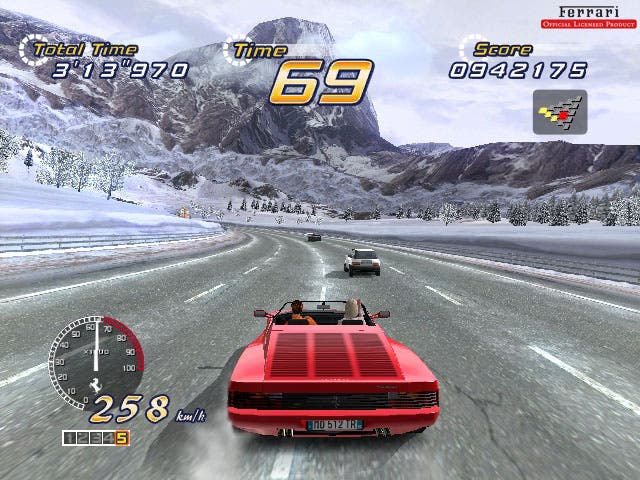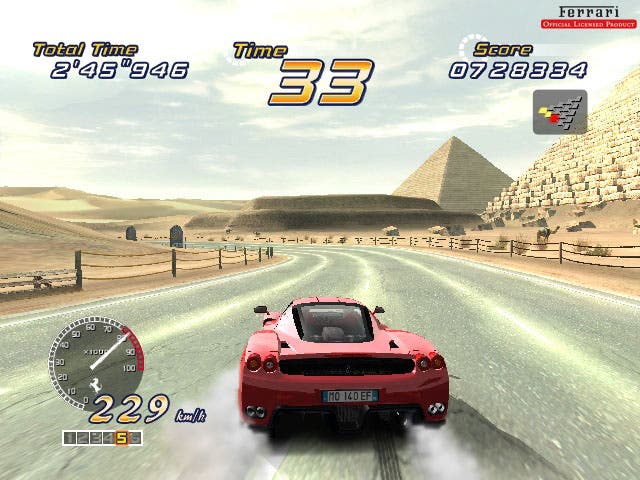OutRun2
It looked spectacular at the arcade. It looks spectacular now. We go hands on with the Xbox version of OutRun2 and see how Sumo Digital plans to give the entire arcade racing genre a kick up the exhaust.
There was a time when "arcade perfect" was one of the most abused phrases in the games journalist's arsenal, guaranteed an airing whenever a good-looking game required thought-free hyperbole at short notice. And it certainly captured the imagination. Arcade quality visuals in the home! Technology that we could never possibly afford emulated to within a fraction of its former brilliance!
Sadly, of course, the games in question rarely ever lived up to expectation, much as endless claims of improved artificial intelligence rarely satisfy their ambitious sales pitches in this day and age, and after a while "arcade perfect" slipped out of the average journo's rotation. And perhaps for the best.
From our perspective though, right here and right now the loss of a once proud cliché is proving rather unfortunate, because there are no two more suitable words we could use to describe the work of Sumo Digital, the Sheffield-based developer of the Xbox OutRun2, which is every bit as beautiful, ambitious and fluid to play as its Chihiro-based arcade forerunner. Which is 'very', just in case anybody's in any doubt.
Cloud nine

OutRun2, much like its 80s predecessor, is built on a combination of a simple premise and accessible, fine-tuned and engrossing core racing gameplay. The idea is simply to pick a Ferrari (including but not limited to a Dino 246 GTS, 360 Spider, Testarossa, F50 and Enzo), and then tear through five themed sections, choosing to turn left or right at the end of each area depending on whether we want an easier (left) or harder (right) challenge from the next. Each section taken individually is a miniature work of art, and presents a troublesome range of twists and turns, sometimes utilising the undulating landscape to good effect - furthering the challenge by forcing you to react as you dive out of the clouds and sunlight blurs your vision of an impending turn. Depending on your overall time, the quality of your race and the difficulty of your route, the game eventually computes a final score, which pits you against the rest of the leaderboard.
What keeps us playing though is partly the immaculate sense of speed, which, much like the game's dazzling visuals and riveting challenge, the developer has done an exemplary job of preserving, and partly the strength of the racing model, which calls on a faintly Ridge Racer-esque use of absurd powerslides. By dabbing the brake as we dive into a corner, the Ferrari twists into a slide, which we can then use to steadily creep around the outside of AI-controlled traffic by tweaking the accelerator and correcting the turn with the left analogue stick. Failure to do so may see cars flip and spin on hard contact with barriers, but they won't take damage - as the emphasis is firmly on arcade challenge rather than driving realism.
We can also opt to change camera mode, switching between third-person, dashboard or bumper views, and due to the heavy emphasis on sliding it's the third-person option which proves the most enduring. The bumper cam feels faster, but it adds to the challenge by forcing us to pre-judge the slide based on the arc of the turn, the position of other cars and then how close our face is to the barrier on the inside. Ultimately third-person is the obvious (and default) choice, and just as well really, because it also gives us a chance to enjoy the detail on each of the car models, which glimmer in the sun as buildings, clouds and flawless scenery slide over the bonnet in the grip of glassy real-time reflections.
Heartbreaker

Heart Attack mode, meanwhile, pits the player against a number of specific challenges over various stages, all in the name of impressing the gorgeous gal in the passenger seat. As we round a turn she might demand that we speed past a number of shaded cars, and with every car we pass a little heart gage will visualise her palpitations. Or we might be asked to race through a shaded area of track, sliding until the last possible moment. At the end of the race we're graded based on how close we came to flat-lining her, before driving off to a secluded spot and, in Friends parlance, 'consummating like bunnies'. (At least, we guess that's what happens while we're entering our initials.)
But, if you believe Sega, the OutRun2 arcade title alone wasn't enough to justify an Xbox outing, gorgeous and addictive though it undoubtedly was. As one rep put it, a straight port of the arcade game would probably do good business in Japan, but in the West it would turn into a one-night rental, after which time the player would have seen close to everything the game had to offer, even if he had failed to grasp every last nuance of its absorbent racing model and sumptuous visuals.
With this in mind, Sega knew it had to harness a game conceived and developed for a very specific niche market, and build it into the sort of title Xbox owners would happily shell out for. There is a genuine sense that the publisher wants to make games more suitable for the global market now - to improve profitability - but on the flipside the publisher also wants to maintain its undisputed artistic integrity. In order to do this in the case of OutRun2, the publisher recruited Sumo Digital, who, as far as we could make out, simply showed the most passion for what the publisher regards as a very delicate project.
Run to Live

Thanks to a strong relationship with arcade developer AM2 (and full access to the source code), Sumo's port should be brimming with added value features by the time it screeches into stores in the fourth quarter, and the most significant additions at this point are various Xbox Live options. Online gamers should be catered for both in competitive terms with four-player head-to-head racing, and thanks to Project Gotham Racing 2-style ghost car and high score uploads.
The Time Attack mode will also survive, and we'd be surprised if the arcade version's facility to take passwords home and upload them to the Internet, and then see high-ranking ghost cars propagated across nationwide arcade units, doesn't translate into some form of Xbox Live feature. What's more, although four players is the figure we've seen quoted (and the number of units linked up at E3), Sega reps told us that the final number of players is still to be confirmed.
In fact, the only problem that Sega seemed to own up to was that the greater the number of players, the less crowded the road will be (apparently thanks to the inherent difficulty in keeping up with a host of AI-controlled vehicles and human racers). By all accounts the Live aspect of OutRun2 will be one of its standout features, and although we're still waiting to hear specifics of the Xbox game's Mission Modes and other features, the talk of builds featuring blocking and other tweaks suggests that Sumo isn't being restrained when it comes to altering the framework outside the original arcade modes.
Picture perfect
And, to get back to where we came in, it's arguably an arcade perfect port. The quality of the car models, the reflections, the way sparks sheer off wire mesh as we grate up against it, the way grass flies up into the camera as we misjudge a slide and edge two wheels off the road, the epic draw distance, the bump mapped environments and atmospheric effects, the glassy water as we drive over a suspension bridge, the sense of speed and beautiful range of weather and lighting scenarios, even the way the girl sitting next to the driver clobbers him on the head if he runs out of time. All delivered at a blemish-free 60 frames per second, and if there have been any compromises then they're imperceptible (and don't just take our word for it - when we played the game, we were sitting in the room with an OutRun die hard, who felt much the same way).
Driving past rows of trees and woodland, for example, it's impossible to ignore the lack of texture blockiness we've come to expect from this sort of product, even as we squint closer to the screen. Although each tree evidently relies on the same model or a slightly different version of the last one, taken as a group they paint a vivid picture.
Long after we walked away from the game, we were still gorging ourselves mentally on its picturesque landscapes; the wispy cloud hugging the sky as we clambered over the brow of a hill and down into the sun-drenched valley beyond, where we could almost see the moisture lingering in the air and the sun racing across the lake as we sped past. The Metropolis level, modelled on various European cities, is one of the standout sections of the game, full of Parisian street cafes, dominated by the sight of the Eiffel Tower looming large over a sea of lights and culminating in a headlong charge along the Champs-Elysées towards the chequered flag. In fact, it's such a gorgeous spectacle that anybody watching has just as much fun basking in the unparalleled quality of the visuals as the driver does wrapping his thumbs around the sticks and triggers, something which is also true of Palm Beach, Cloudy Highland, Industrial Complex, Ghost Forest and any number of other sections we could mention.
Time Over
Actually, perhaps spectators won't be having quite as much fun - but probably only because they're too busy trying to politely claw the pad away for their own turn. Thanks to constant tweaking, Sumo has managed to capture the feel of the arcade version's steering and map it to the analogue stick and triggers with real precision, meaning that what was once a linear steering wheel and pedal-based control scheme now feels perfectly at home on Microsoft's black box, and - though it'll likely be tweaked right up to release - if it's this enjoyable to play right now then it's bound to be even more accessible, intuitive and rewarding when we can buy it from our local GAME.
The signs are certainly good, and the attention to detail is impossible to ignore. Apart from all we've already made of the visuals and handling, we've also seen the game running in widescreen mode (although the HUD still has to be resized to fit), heard sound pouring out of surround sound speakers and confirmed that the original arcade OutRun mode is essentially complete, and that tweaks, extra modes and Live support will be dominating Sumo's schedule for the foreseeable future. Sumo's dedication to expansion even stretches to the soundtrack - with four original tunes joining three arcade survivors in a gloriously disarming tribute to breezy risk-free driving.
Whether it is a foreseeable future for this most dazzling of arcade racers is more difficult to say. Sega Europe is shooting for a narrow window (tentatively in October) so that the game isn't swept away by the marketing hype affixed to rival racers like Burnout 3, Juiced and Crash 'n' Burn. And it's difficult to see how else to do it. We only hope that when its slides meet hairpins for the first time, gamers will appreciate the significance and replay value of the single-player experience in spite of its brevity, and that Sumo's value added extras aren't frittered away into half-baked boxouts to make way for Burnout cover splashes. Comfortingly, if they can match the quality of the Sheffield developer's arcade conversion, then they should be hard to ignore.




.png?width=291&height=164&fit=crop&quality=80&format=jpg&auto=webp)



